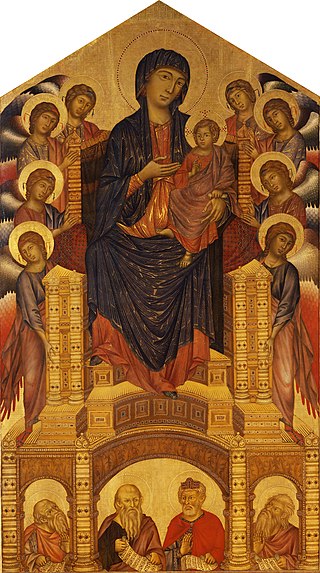
Giovanni Cimabue, c. 1240 – 1302, was an Italian painter and designer of mosaics from Florence. He was also known as Cenni di Pepo or Cenni di Pepi.

A mosaic is a pattern or image made of small regular or irregular pieces of colored stone, glass or ceramic, held in place by plaster/mortar, and covering a surface. Mosaics are often used as floor and wall decoration, and were particularly popular in the Ancient Roman world.

The Albert Memorial, directly north of the Royal Albert Hall in Kensington Gardens, London, was commissioned by Queen Victoria in memory of her beloved husband Prince Albert, who died in 1861. Designed by Sir George Gilbert Scott in the Gothic Revival style, it takes the form of an ornate canopy or pavilion 176 feet (54 m) tall, in the style of a Gothic ciborium over the high altar of a church, sheltering a statue of the prince facing south. It took over ten years to complete, the £120,000 cost met by public subscription.

Since ancient times, Greeks, Etruscans and Celts have inhabited the south, centre and north of the Italian peninsula respectively. The very numerous rock drawings in Valcamonica are as old as 8,000 BC, and there are rich remains of Etruscan art from thousands of tombs, as well as rich remains from the Greek colonies at Paestum, Agrigento and elsewhere. Ancient Rome finally emerged as the dominant Italian and European power. The Roman remains in Italy are of extraordinary richness, from the grand Imperial monuments of Rome itself to the survival of exceptionally preserved ordinary buildings in Pompeii and neighbouring sites. Following the fall of the Roman Empire, in the Middle Ages Italy remained an important centre, not only of the Carolingian art, Ottonian art of the Holy Roman Emperors, Norman art, but for the Byzantine art of Ravenna and other sites.

Gino Severini was an Italian painter and a leading member of the Futurist movement. For much of his life he divided his time between Paris and Rome. He was associated with neo-classicism and the "return to order" in the decade after the First World War. During his career he worked in a variety of media, including mosaic and fresco. He showed his work at major exhibitions, including the Rome Quadrennial, and won art prizes from major institutions.

Anton Alexander von Werner was a German painter known for his history paintings of notable political and military events in the Kingdom of Prussia.
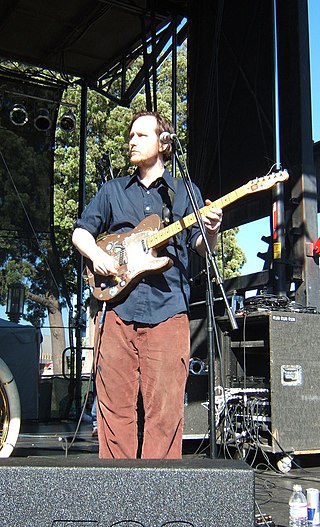
Circulatory System is a psychedelic rock musical ensemble formed by musician/painter Will Cullen Hart, and featuring Derek Almstead, Suzanne Allison, Peter Erchick, John Fernandes, Charlie Johnston, and Heather McIntosh.
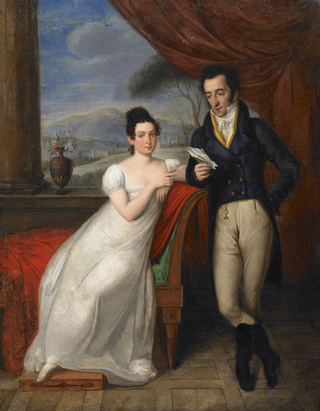
Vincenzo Camuccini was an Italian painter of Neoclassic histories and religious paintings. He was considered the premier academic painter of his time in Rome.

Sir William Blake RichmondPPRBSA was a British painter, sculptor and a designer of stained glass and mosaic. He is best known for his portrait work and decorative mosaics in St Paul's Cathedral in London.

Pavel Dmitriyevich Korin was a Russian painter and art restorer. He is famous for his preparational work for the unimplemented painting Farewell to Rus.

Albanian art refers to all artistic expressions and artworks in Albania or produced by Albanians. The country's art is either work of arts produced by its people and influenced by its culture and traditions. It has preserved its original elements and traditions despite its long and eventful history around the time when Albania was populated to Illyrians and Ancient Greeks and subsequently conquered by Romans, Byzantines, Venetians and Ottomans.

Jacopo Torriti or Turriti was an Italian painter and mosaic maker who lived in the 13th century.

Pietro della Vecchia, Pietro della Vècchia or Pietro Vècchia, formerly incorrectly called Pietro Muttoni was a versatile Italian painter who worked in many genres and created altarpieces, portraits, genre scenes and grotesques. He also created pastiches of the work of leading Italian painters of the 16th century. He designed cartoons for mosaics and worked as an art restorer. Della Vecchia was also sought after as an art expert and did expert valuations of artworks. He worked most of his life in Venice and its environs except for a brief stay in Rome.

Gaddo Gaddi was a painter and mosaicist of Florence in a Gothic art style. Almost no works survive. He was the father of Taddeo Gaddi. He completed mosaics on the facade of Santa Maria Maggiore in Rome. The "Coronation of the Virgin" mosaic over the inside door of Florence Cathedral, dated 1307, is also attributed to Gaddo Gaddi.
The decade of the 1290s in art involved some significant events.
The decade of the 1300s in art involved some significant events.

Philoxenus of Eretria was a painter from Eretria. He was a disciple of Nicomachus of Thebes, whose speed in painting he imitated and even surpassed, having discovered new and rapid methods of coloring. According to Pliny, a picture of his was inferior to none, in particular his depiction of a battle between Alexander the Great and Darius, which he painted for King Cassander.

Ancient Greek art stands out among that of other ancient cultures for its development of naturalistic but idealized depictions of the human body, in which largely nude male figures were generally the focus of innovation. The rate of stylistic development between about 750 and 300 BC was remarkable by ancient standards, and in surviving works is best seen in sculpture. There were important innovations in painting, which have to be essentially reconstructed due to the lack of original survivals of quality, other than the distinct field of painted pottery.
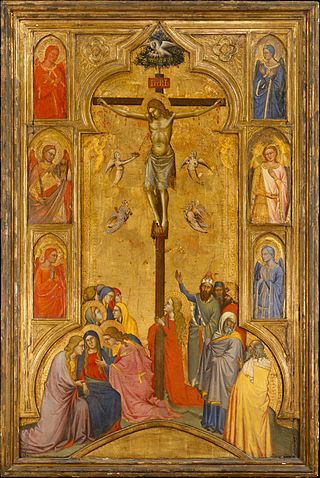
Gold ground or gold-ground (adjective) is a term in art history for a style of images with all or most of the background in a solid gold colour. Historically, real gold leaf has normally been used, giving a luxurious appearance. The style has been used in several periods and places, but is especially associated with Byzantine and medieval art in mosaic, illuminated manuscripts and panel paintings, where it was for many centuries the dominant style for some types of images, such as icons. For three-dimensional objects, the term is gilded or gold-plated.
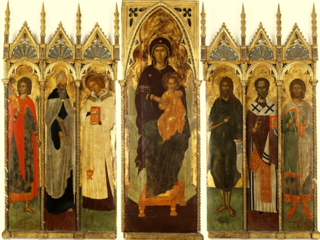
Nikolaos Philanthropinos, also known as Nicolaos Philanthropenos and Nicolaus Filantropinó or Philastropino, was a Greek Byzantine painter. He was active in Crete, Venice, and Constantinople. He was a very famous painter during the onset of the Italian Renaissance, the end of the Palaeologan Renaissance and the beginning of the Greek Renaissance. He worked with Venetian master Nicolaus Storlado. His contemporaries in Crete were Manuel Fokas and Ioannis Pagomenos. He brought the art of Constantinople to Venice and Crete. He influenced both Greek and Italian art. Artists he influenced include: Angelos Akotantos and Andreas Ritzos. He completed some mosaics for St Mark's Basilica in Venice.


















